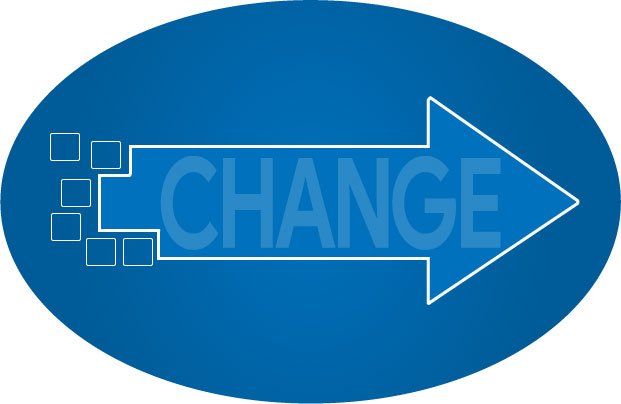
Thomas Edison once said, “There’s a way to do it better – find it.”
Edison knew change is a good thing and that change is necessary.
Change is happening at an unprecedented rate in today’s technological landscape. As such, mastering the art of change provides a critical competitive advantage for companies willing to do the work.
- Just 20 years ago, large organizations underwent significant changes or reorganizations every 7 years on average.
- In today’s environment, it’s more like every 7 months.
However, the failure rate of change management initiatives is approximately 70%.
And strangely enough, many organizations that operate with the traditional change management model are experiencing unplanned and sometimes undesired changes along the way.
Change is the only constant, so finding a solution is critical. And that solution may very well lie in a simple change in vernacular and a pivot in approach.
Let’s begin by taking a look at traditional change management.
Change Management
Change has the ability to put project success at risk and to put people on edge. So project coordinators have attempted to control change by levying management strategies upon the process.
The term ‘change management’ implies that the change is happening to employees and is outside of their control.
Change management is a complex undertaking. Change management attempts to shift a process toward a desired outcome and achieve strategic organizational objectives.
Often, however, the project experiences drift rather than shift.
As previously mentioned, sometimes with traditional change management, unplanned and undesired changes, called drift, occur and alter the trajectory of a project. Drift is when external influences impact a project and cause outcomes that were not originally requested or desired by the stakeholders.
A contributing factor of drift lies within the tenets of change management. Change management is a top-down approach that focuses the attention and true understanding of the change initiative only on a small number of stakeholders.
An approach like this often results in resistance due to lack of information.
- The trickle-down assumption involved with change management positions top-management as the sole authority of change and the employees merely as vehicles for implementation. Employee insights are disregarded and buy-in naturally is weakened.
- Organizations that control change in this way are often also geared toward risk-avoidance, routine and deference to authority. In such an environment, employees are unlikely to raise concerns or share ideas for effective alternatives.
If drift is to be resolved, organizations should consider a mindset shift from change management to change enablement.
The Shift Towards Change Enablement
The word enablement is defined as the act of giving authority or means to do something.
According to McKinsey and Co., “when people are truly invested in change it is 30% more likely to stick.”
When organizations embrace change enablement, they empower everyone in the organization by allowing them to influence and own the change.
Now, employees see change as something that will benefit them. They become invested and begin thinking about the change as an opportunity rather than an obligation.
Change Management vs. Change Enablement: 4 Key Differences
- Rather than a top-down ownership approach, change enablement involves everyone throughout the organization sharing responsibility for and ideas about the change.
- Rather than a top-down communication push approach, change enablement involves transparent company-wide two-way communication about why change should happen, how it should happen and how it will benefit everyone.
- Rather than placing emphasis on checklists and outcomes, change enablement focuses on adoption strategies and progress.
- Traditional change management is structured with a beginning middle and end, while change enablement is iterative and is designed to be modified as needed.
How to Deploy a Change Enablement Program
Step 1: Consider infrastructure
To facilitate change enablement, the right infrastructure is key and will rely heavily on tools, training and support.
- Tools. When it comes to tools, preparation and flexibility are key. Do you need new software? If so, consider the number of seats, download time and memory capacity. Does a learning management tool make sense for your organization?
- Training. Be intentional and concise when communicating about new expectations, norms and responsibilities. Place importance on identifying proactive training needs and delivering just-in-time training.
- Support. Support and reinforce the iterative nature of the process. Encourage teams to voice concerns and questions. Maintain focus on progress rather than outcome.
Step 2: Personalize the experience
Filter information so it becomes uniquely relevant for the user.
- Address the role and contribution of each individual throughout the organization.
By clarifying priorities in this way, you increase accountability, encourage positive peer pressure and mitigate resistance.
Step 3: Build community and shared purpose
With organizations operating in an increasingly global and physically-distanced capacity, providing opportunities for colleagues to collaborate is powerful.
- When everyone can see the information related to the change process, the experience feels shared.
- When the team develops empathy for one another in this way, commitment to the project strengthens and adoption becomes easier.
Step 4: Showcase progress
Throughout the process of organizational change, it is common for a core group of people to track and notice the progress. Rather than keep this information contained, spread the word.
People feel empowered when they see the change happening as a result of their efforts.
There are many digital change management tools that can be helpful to communicate progress in real time. This creates momentum that can move employees from adoption to real implementation of the change.
Final Thoughts
Change won’t happen overnight. With change enablement, once change does happen, the process is iterative and doesn’t end.
- Teams continue to share information about how they are instituting the change in their everyday work processes.
- This feedback should continue to transform the process.
In today’s fast-paced environment, companies who enable change rather than simply manage it will gain competitive advantage and score the ability to implement new processes faster and more efficiently than the rest of the industry.
Learn More Today
Many IT processes benefit from the visibility a change management database (CMDB)rovides, but change enablement continues to be a leading driver for organizations that decide to implement a (CMDB).
Device42’s powerful CMDB with comprehensive auto discovery and application dependency mapping makes the data required for important decisions available to all involved. Device42’s change enablement tools provide that ‘instant access’ to the important answers. Contact Device42 for a free demo today.



